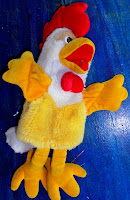Puppets: 3 or more forest animals of varied size, Bear, Mouse
Props: Felt mittens of five or more sizes, plus a board to stick them onPresenters: One
Audience: Toddlers (1’s and 2’s) or Preschoolers
The Mitten has been a storytime favorite for librarians for a long time, and there are many ways to tell it. We have a neat little stretchy mitten at our library with some small stuffed animals that you cram in there as you tell the tale, and that works great for smaller audiences. On the opposite side of the scale, some tellers use kids as the animals along with a huge mitten made out of a sheet for them to enter…I remember seeing Todd Dunkelberg of the Deschutes County Library do a great version of it this way.
My favorite way is with puppets and felt, probably because it’s simple…and I just like puppets. I just use a poster-sized felt board that can stand up. I don’t have an actual felt board, so I just use the lid to one of my puppet pins, use book ends to stand it up, and tape some fabric onto it. My puppets are in a bag, in size order, and the mittens are stacked behind the board, also in size order. Then the story almost tells itself.
I start by telling about the boy who took his mittens off in the snow and lost one of them, then stick the lost one on the board. Rabbit pops out of the bag, sees the the mitten and hops in to get warm. His entry is just a hop behind the board. Then it’s: “He fit inside, but the mitten stretched a little bit bigger.” Then I replace that smallest mitten with the next size up.
The pattern continues with the next animal. From now on,
The pattern continues with the next animal. From now on,
though, when Chipmunk (or whoever) hops toward the mitten, the animal who just entered pops out to rebuff him, until the new animal convinces the other that there must be room for one more. I like this piece because you get some good puppet interaction. It does take a bit of practice, since you have to be getting the in-the-mitten puppet onto your off hand while at the same time you’re moving and talking with the out-of-the-mitten puppet. With a preschool audience, I’ll have the puppets spar a bit, with Chipmunk trying to sneak past and Rabbit heading him off just in time. But with Toddlers we don’t need any of that…just meet, talk, and into the mitten. When the new animal is allowed in, you trade up a mitten size, and on the story goes.
A nice big Bear puppet makes the ending especially fun, since the audience can see there’s no way he could fit too. And once he does go in, I hesitate a bit before bringing out the biggest mitten…which isn’t big enough for Bear really, but is big enough to get a “wow” or two out of the young audience.
 Though I follow the Alvin Tresselt version that I learned it from for most of the telling, I do like Jan Brett’s twist of having Mouse tickle Bear’s nose to cause the sneeze that bursts the mitten apart. The audience can supply the big “achoo!” and I just reach behind the board and toss all of the animals up in the air. Tossing everyone at once is fun, but I think it works a bit better to do it one after another. Either way it's always fun to toss a bunch of puppets in Storytime (see also Mr. Gumpy's Outing and The Napping House)
Though I follow the Alvin Tresselt version that I learned it from for most of the telling, I do like Jan Brett’s twist of having Mouse tickle Bear’s nose to cause the sneeze that bursts the mitten apart. The audience can supply the big “achoo!” and I just reach behind the board and toss all of the animals up in the air. Tossing everyone at once is fun, but I think it works a bit better to do it one after another. Either way it's always fun to toss a bunch of puppets in Storytime (see also Mr. Gumpy's Outing and The Napping House)
To end it (after gathering up animals as quickly as I can), I like to hold the biggest mitten in one hand and the smallest in the other: “The next day, the boy found his missing mitten…but there was something different about it….”
* Versions by Jan Brett and Jim Aylesworth/Barbara McClintock are also excellent








































